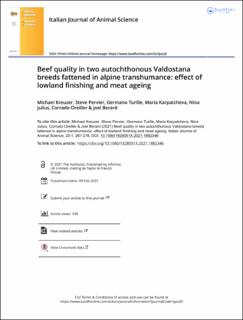Please use this identifier to cite or link to this item:
https://doi.org/10.21256/zhaw-22975Full metadata record
| DC Field | Value | Language |
|---|---|---|
| dc.contributor.author | Kreuzer, Michael | - |
| dc.contributor.author | Pervier, Steve | - |
| dc.contributor.author | Turille, Germano | - |
| dc.contributor.author | Karpatcheva, Maria | - |
| dc.contributor.author | Julius, Nina | - |
| dc.contributor.author | Oreiller, Corrado | - |
| dc.contributor.author | Berard, Joel | - |
| dc.date.accessioned | 2021-08-19T12:32:07Z | - |
| dc.date.available | 2021-08-19T12:32:07Z | - |
| dc.date.issued | 2021 | - |
| dc.identifier.issn | 1828-051X | de_CH |
| dc.identifier.uri | https://digitalcollection.zhaw.ch/handle/11475/22975 | - |
| dc.description.abstract | European consumers demand locally produced meat, preferably from regional breeds, but meat quality is unknown. Heifers from two dual-purpose breeds, Valdostana Chestnut (VC) and Valdostana Red Pied (VR), autochthonous to the Aosta valley, were compared with Piedmontese (PI), a beef breed. Fourteen VC and VR each grazed high alpine pastures, and ten PI received fresh grass in a lowland barn. In each group, the heavier half of the animals were slaughtered after the grass-feeding period. All others received hay and concentrate for another 48 days. Properties of the carcase and the longissimus thoracis (LT) and biceps femoris (BF) muscles (aged 7 or 28 days) were determined. Sensory analysis of the LT and BF muscles was performed by 10 trained panellists and 53 consumers, respectively. The VC and VR grew faster than the PI, but dressing percentages and conformation scores were inferior. The LT was perceived as less tender from the VC and VR compared to the PI, and shear force and insoluble collagen were also higher. Finishing accentuated the problem for VC and did not improve carcase and meat quality otherwise. Prolonged ageing did not render the beef more tender. Compared to the LT, the BF was more resistant to factors of influence in quality. Consumers perceived long-aged beef to be preferable and comparably inexpensive for its quality. No other factor influenced sensory impression. In conclusion, the LT and, less so, the BF from the autochthonous breeds were not fully competitive in quality with those of the beef breed. | de_CH |
| dc.language.iso | en | de_CH |
| dc.publisher | Taylor & Francis | de_CH |
| dc.relation.ispartof | Italian Journal of Animal Science | de_CH |
| dc.rights | http://creativecommons.org/licenses/by/4.0/ | de_CH |
| dc.subject | Valdostana Chestnut | de_CH |
| dc.subject | Valdostana Red Pied | de_CH |
| dc.subject | Piedmontese | de_CH |
| dc.subject | Meat quality | de_CH |
| dc.subject | Growth performance | de_CH |
| dc.subject.ddc | 630: Landwirtschaft | de_CH |
| dc.title | Beef quality in two autochthonous Valdostana breeds fattened in alpine transhumance : effect of lowland finishing and meat ageing | de_CH |
| dc.type | Beitrag in wissenschaftlicher Zeitschrift | de_CH |
| dcterms.type | Text | de_CH |
| zhaw.departement | Life Sciences und Facility Management | de_CH |
| zhaw.organisationalunit | Institut für Lebensmittel- und Getränkeinnovation (ILGI) | de_CH |
| dc.identifier.doi | 10.1080/1828051X.2021.1882346 | de_CH |
| dc.identifier.doi | 10.21256/zhaw-22975 | - |
| zhaw.funding.eu | No | de_CH |
| zhaw.issue | 1 | de_CH |
| zhaw.originated.zhaw | Yes | de_CH |
| zhaw.pages.end | 278 | de_CH |
| zhaw.pages.start | 267 | de_CH |
| zhaw.publication.status | publishedVersion | de_CH |
| zhaw.volume | 20 | de_CH |
| zhaw.publication.review | Peer review (Publikation) | de_CH |
| zhaw.webfeed | Sensorik | de_CH |
| zhaw.author.additional | No | de_CH |
| zhaw.display.portrait | Yes | de_CH |
| Appears in collections: | Publikationen Life Sciences und Facility Management | |
Files in This Item:
| File | Description | Size | Format | |
|---|---|---|---|---|
| 2021_Kreuzer-etal_Beef-quality-in-two-autochthonous-Valdostana-breeds.pdf | 1.43 MB | Adobe PDF |  View/Open |
Show simple item record
Kreuzer, M., Pervier, S., Turille, G., Karpatcheva, M., Julius, N., Oreiller, C., & Berard, J. (2021). Beef quality in two autochthonous Valdostana breeds fattened in alpine transhumance : effect of lowland finishing and meat ageing. Italian Journal of Animal Science, 20(1), 267–278. https://doi.org/10.1080/1828051X.2021.1882346
Kreuzer, M. et al. (2021) ‘Beef quality in two autochthonous Valdostana breeds fattened in alpine transhumance : effect of lowland finishing and meat ageing’, Italian Journal of Animal Science, 20(1), pp. 267–278. Available at: https://doi.org/10.1080/1828051X.2021.1882346.
M. Kreuzer et al., “Beef quality in two autochthonous Valdostana breeds fattened in alpine transhumance : effect of lowland finishing and meat ageing,” Italian Journal of Animal Science, vol. 20, no. 1, pp. 267–278, 2021, doi: 10.1080/1828051X.2021.1882346.
KREUZER, Michael, Steve PERVIER, Germano TURILLE, Maria KARPATCHEVA, Nina JULIUS, Corrado OREILLER und Joel BERARD, 2021. Beef quality in two autochthonous Valdostana breeds fattened in alpine transhumance : effect of lowland finishing and meat ageing. Italian Journal of Animal Science. 2021. Bd. 20, Nr. 1, S. 267–278. DOI 10.1080/1828051X.2021.1882346
Kreuzer, Michael, Steve Pervier, Germano Turille, Maria Karpatcheva, Nina Julius, Corrado Oreiller, and Joel Berard. 2021. “Beef Quality in Two Autochthonous Valdostana Breeds Fattened in Alpine Transhumance : Effect of Lowland Finishing and Meat Ageing.” Italian Journal of Animal Science 20 (1): 267–78. https://doi.org/10.1080/1828051X.2021.1882346.
Kreuzer, Michael, et al. “Beef Quality in Two Autochthonous Valdostana Breeds Fattened in Alpine Transhumance : Effect of Lowland Finishing and Meat Ageing.” Italian Journal of Animal Science, vol. 20, no. 1, 2021, pp. 267–78, https://doi.org/10.1080/1828051X.2021.1882346.
Items in DSpace are protected by copyright, with all rights reserved, unless otherwise indicated.